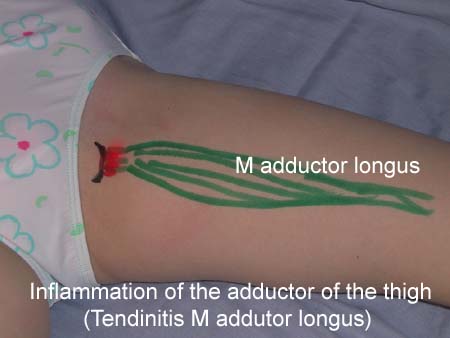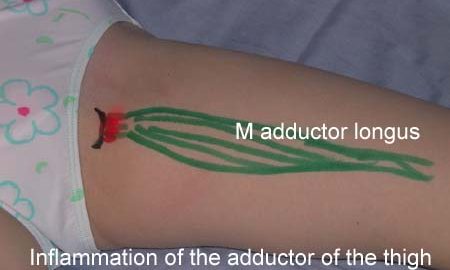




|
Effectiveness of active physical training as treatment for long-standing adductor-related groin pain in athletes: randomised trial. METHODS. FINDINGS. INTERPRETATION. |
|
Longstanding groin pain in athletes. A multidisciplinary approach. |


Training ladder for:
INFLAMMATION OF THE ADDUCTOR OF THE THIGH
(TENDINTIS M ADDUKTOR LONGUS)
STEP 4 |
Unlimited: Cycling. Swimming. Running on a soft surface.
|
||||||||||||||||||||||||||||||||||||||||||||||||||||||||||||||||||||||
|
Stretching is carried out in the following way: stretch the muscle group for 3-5 seconds. Relax for 3-5 seconds. The muscle group should subsequently be stretched for 20 seconds. The muscle is allowed to be tender, but must not hurt. Relax for 20 seconds, after which the procedure can be repeated. The time consumed for stretching, coordination and strength training can be altered depending on the training opportunities available and individual requirements. |
Training ladder for:
INFLAMMATION OF THE ADDUCTOR OF THE THIGH
(TENDINTIS M ADDUKTOR LONGUS)
STEP 3 |
Unlimited: Cycling. Swimming. Jogging on a soft surface without sudden directional change.
|
|||||||||||||||||||||||||||||||||||||||||||||||||||||||||||||||||
|
Stretching is carried out in the following way: stretch the muscle group for 3-5 seconds. Relax for 3-5 seconds. The muscle group should subsequently be stretched for 20 seconds. The muscle is allowed to be tender, but must not hurt. Relax for 20 seconds, after which the procedure can be repeated. The time consumed for stretching, coordination and strength training can be altered depending on the training opportunities available and individual requirements. |
Training ladder for:
INFLAMMATION OF THE ADDUCTOR OF THE THIGH
(TENDINTIS M ADDUKTOR LONGUS)
STEP 2 |
Unlimited: Cycling. Swimming.
|
||||||||||||||||||||||||||||||||||||||||||||||||||||||||||||||||||||||
|
Stretching is carried out in the following way: stretch the muscle group for 3-5 seconds. Relax for 3-5 seconds. The muscle group should subsequently be stretched for 20 seconds. The muscle is allowed to be tender, but must not hurt. Relax for 20 seconds, after which the procedure can be repeated. The time consumed for stretching, coordination and strength training can be altered depending on the training opportunities available and individual requirements. |
Training ladder for:
INFLAMMATION OF THE ADDUCTOR OF THE THIGH
(TENDINTIS M ADDUKTOR LONGUS)
STEP 1 |
| The indications of time after stretching, coordination training and strength training show the division of time for the respective type of training when training for a period of one hour. The time indications are therefore not a definition of the daily training needs, as the daily training is determined on an individual basis.
|
||||||||||||||||||||||||||||||||||||||||||||||||||||||||||||||||
|
Stretching is carried out in the following way: stretch the muscle group for 3-5 seconds. Relax for 3-5 seconds. The muscle group should subsequently be stretched for 20 seconds. The muscle is allowed to be tender, but must not hurt. Relax for 20 seconds, after which the procedure can be repeated. The time consumed for stretching, coordination and strength training can be altered depending on the training opportunities available and individual requirements. |